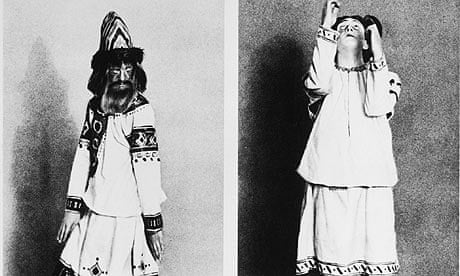The audience, packed into the newly-opened Théâtre des Champs-Élysées to the point of standing room only, had neither seen nor heard anything like it.
As the first few bars of the orchestral work The Rite of Spring – Le Sacre du Printemps – by the young, little-known Russian composer Igor Stravinsky sounded, there was a disturbance in the audience. It was, according to some of those present – who included Marcel Proust, Pablo Picasso, Gertrude Stein, Maurice Ravel and Claude Debussy – the sound of derisive laughter.
By the time the curtain rose to reveal ballet dancers stomping the stage, the protests had reached a crescendo. The orchestra and dancers, choreographed by the legendary Vaslav Nijinsky, continued but it was impossible to hear the music above what Stravinsky described as a "terrific uproar".
As a riot ensured, two factions in the audience attacked each other, then the orchestra, which kept playing under a hail of vegetables and other objects. Forty people were forcibly ejected.
The reviews were merciless. "The work of a madman … sheer cacophony," wrote the composer Puccini. "A laborious and puerile barbarity," added Le Figaro's critic, Henri Quittard.
It was 29 May 1913. Classical music would never be the same again.
On Wednesday evening at the same theatre in Paris, a 21st-century audience – hopefully without vegetables — will fill the Théâtre des Champs-Élysées for a reconstruction of the original performance to mark the 100th anniversary of the notorious premiere. It will be followed by a new version of The Rite by the Berlin-based choreographer Sasha Waltz, among a series of commemorative performances.
Today, the piece has gone from rioting to rave reviews and is widely considered one of the most influential musical works of the 20th century.
"It conceals some ancient force, it is as if it's filled with the power of the Earth," Waltz said of Stravinsky's music.
Finnish composer and conductor Esa-Pekka Salonen, currently principal conductor and artistic adviser for the Philharmonia Orchestra in London, who will conduct the Rite of Spring at the Royal Festival Hall on Thursday and at the Théâtre des Champs-Élysées shortly afterwards , said The Rite still made his spine tingle. "I have to admit that when we come to the moment just before the last dance … my blood pressure is up. I have this kind of adrenaline surge," he told Reuters.
"It's an old caveman reaction."
Salonen added: "The miracle of the piece is the eternal youth of it. It's so fresh, it still kicks ass."
There is still confusion and disagreement about events that night in 1913, which the theatre describes as "provoking one of the greatest scandals in the history of music" and turning The Rite into the "founding work of all modern music".
Stravinsky, was virtually unknown before Sergei Diaghilev hired him to compose for his Ballets Russes's 1913 Paris season. His first two works, The Firebird, performed in 1910, and Petrushka, in 1911, were generally acclaimed. The Rite, subtitled "Pictures of Pagan Russia in Two Parts", begins with primitive rituals celebrating spring, and ends with a young sacrificial victim dancing herself to death.
Not only was the theatre hall packed that evening in 1913, but the stairways and corridors were full to bursting with excited and jostling spectators.
The Rite opened with an introductory melody adapted from a Lithuanian folk song, featuring a bassoon playing, unusually, at the top of its register, and prompting composer Camille Saint-Saëns to exclaim: "If that's a bassoon, then I'm a baboon!" The heavy, stomping steps were a world away from the elegance of traditional ballet, as the dancers enacted the brutal plot.
As the audience erupted, Diaghilev called for calm and flashed the house lights on and off, while Nijinsky was forced to call out steps to the dancers as the beat of the music was drowned out by the riotous cacophony. Even now there is debate over whether the audience reaction was spontaneous or the work of outraged traditionalists armed with vegetables who had come looking for trouble.
The turbulent premiere was followed by five more relatively peaceful performances before one show in London, which received mixed reviews, but the complete ballet and orchestral work were only performed seven times before the outbreak of the first world war.
After the fighting ended, Diaghilev attempted to revive The Rite of Spring, but found nobody remembered the choreography. By then Nijinsky, the greatest dancer of his generation, was in mental decline.
Since then The Rite has been adapted for and included in an estimated 150 productions around the world including gangster films, a punk rock interpretation, a nightmarish vision of Aboriginal Australia by Kenneth MacMillan, and Walt Disney's 1940s film Fantasia. A commemorative performance was staged at the Royal Albert Hall in London to mark the 50th anniversary of the premiere.
To mark this year's centenary of The Rite of Spring, described by Leonard Bernstein as the most important piece of music of the 20th century, both Sony and Universal have released box sets reprising the best versions in their back catalogues.







Comments (…)
Sign in or create your Guardian account to join the discussion